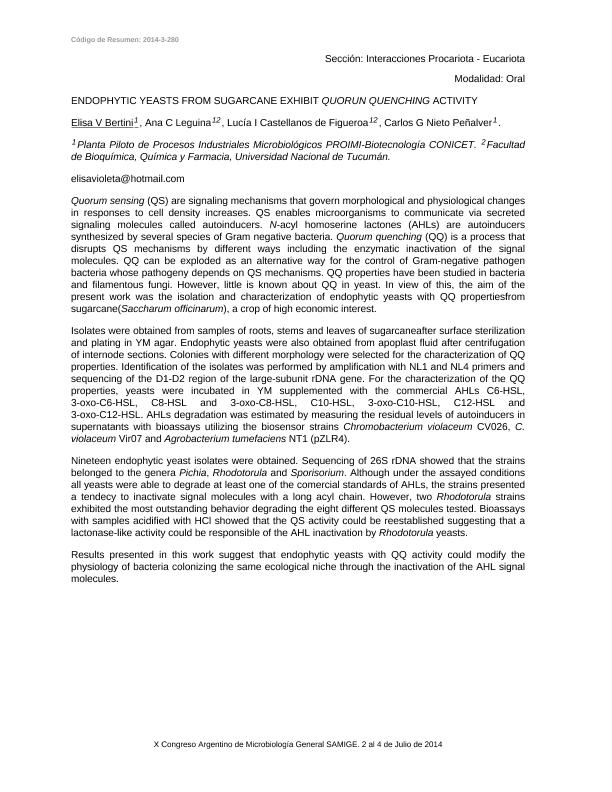Mostrar el registro sencillo del ítem
dc.contributor.author
Bertini, Elisa Violeta

dc.contributor.author
Leguina, Ana Carolina del Valle

dc.contributor.author
Castellanos, Lucia Ines

dc.contributor.author
Nieto Peñalver, Carlos Gabriel

dc.date.available
2023-03-13T13:36:10Z
dc.date.issued
2014
dc.identifier.citation
Endophytic yeasts from sugarcane exhibit quorun quenching activity; X Congreso Argentino de Microbiología General; Mar del Plata; Argentina; 2014; 1-1
dc.identifier.uri
http://hdl.handle.net/11336/190306
dc.description.abstract
Quorum sensing (QS) are signaling mechanisms that govern morphological and physiological changes in responses to cell density increases. QS enables microorganisms to communicate via secreted signaling molecules called autoinducers. N-acyl homoserine lactones (AHLs) are autoinducers synthesized by several species of Gram negative bacteria. Quorum quenching (QQ) is a process that disrupts QS mechanisms by different ways including the enzymatic inactivation of the signal molecules. QQ can be exploded as an alternative way for the control of Gram-negative pathogen bacteria whose pathogeny depends on QS mechanisms. QQ properties have been studied in bacteria and filamentous fungi. However, little is known about QQ in yeast. In view of this, the aim of the present work was the isolation and characterization of endophytic yeasts with QQ propertiesfrom sugarcane(Saccharum officinarum), a crop of high economic interest.Isolates were obtained from samples of roots, stems and leaves of sugarcaneafter surface sterilization and plating in YM agar. Endophytic yeasts were also obtained from apoplast fluid after centrifugation of internode sections. Colonies with different morphology were selected for the characterization of QQ properties. Identification of the isolates was performed by amplification with NL1 and NL4 primers and sequencing of the D1-D2 region of the large-subunit rDNA gene. For the characterization of the QQ properties, yeasts were incubated in YM supplemented with the commercial AHLs C6-HSL, 3-oxo-C6-HSL, C8-HSL and 3-oxo-C8-HSL, C10-HSL, 3-oxo-C10-HSL, C12-HSL and 3-oxo-C12-HSL. AHLs degradation was estimated by measuring the residual levels of autoinducers in supernatants with bioassays utilizing the biosensor strains Chromobacterium violaceum CV026, C. violaceum Vir07 and Agrobacterium tumefaciens NT1 (pZLR4). Nineteen endophytic yeast isolates were obtained. Sequencing of 26S rDNA showed that the strains belonged to the genera Pichia, Rhodotorula and Sporisorium. Although under the assayed conditions all yeasts were able to degrade at least one of the comercial standards of AHLs, the strains presented a tendecy to inactivate signal molecules with a long acyl chain. However, two Rhodotorula strains exhibited the most outstanding behavior degrading the eight different QS molecules tested. Bioassays with samples acidified with HCl showed that the QS activity could be reestablished suggesting that a lactonase-like activity could be responsible of the AHL inactivation by Rhodotorula yeasts. Results presented in this work suggest that endophytic yeasts with QQ activity could modify the physiology of bacteria colonizing the same ecological niche through the inactivation of the AHL signal molecules.
dc.format
application/pdf
dc.language.iso
eng
dc.publisher
Sociedad Argentina de Microbiología General
dc.rights
info:eu-repo/semantics/openAccess
dc.rights.uri
https://creativecommons.org/licenses/by-nc-sa/2.5/ar/
dc.subject
YEAST
dc.subject
ENDOPHYTIC
dc.subject
QUENCHING
dc.subject
SUGARCANE
dc.subject.classification
Biología Celular, Microbiología

dc.subject.classification
Ciencias Biológicas

dc.subject.classification
CIENCIAS NATURALES Y EXACTAS

dc.title
Endophytic yeasts from sugarcane exhibit quorun quenching activity
dc.type
info:eu-repo/semantics/publishedVersion
dc.type
info:eu-repo/semantics/conferenceObject
dc.type
info:ar-repo/semantics/documento de conferencia
dc.date.updated
2023-03-08T14:57:51Z
dc.journal.pagination
1-1
dc.journal.pais
Argentina

dc.journal.ciudad
Buenos Aires
dc.description.fil
Fil: Bertini, Elisa Violeta. Consejo Nacional de Investigaciones Científicas y Técnicas. Centro Científico Tecnológico Conicet - Tucumán. Planta Piloto de Procesos Industriales Microbiológicos; Argentina
dc.description.fil
Fil: Leguina, Ana Carolina del Valle. Consejo Nacional de Investigaciones Científicas y Técnicas. Centro Científico Tecnológico Conicet - Tucumán. Planta Piloto de Procesos Industriales Microbiológicos; Argentina
dc.description.fil
Fil: Castellanos, Lucia Ines. Consejo Nacional de Investigaciones Científicas y Técnicas. Centro Científico Tecnológico Conicet - Tucumán. Planta Piloto de Procesos Industriales Microbiológicos; Argentina
dc.description.fil
Fil: Nieto Peñalver, Carlos Gabriel. Consejo Nacional de Investigaciones Científicas y Técnicas. Centro Científico Tecnológico Conicet - Tucumán. Planta Piloto de Procesos Industriales Microbiológicos; Argentina
dc.relation.alternativeid
info:eu-repo/semantics/altIdentifier/url/https://samige.org.ar/wp-content/uploads/2022/10/LIBRO-SAMIGE-2014.pdf
dc.conicet.rol
Autor

dc.conicet.rol
Autor

dc.conicet.rol
Autor

dc.conicet.rol
Autor

dc.coverage
Nacional
dc.type.subtype
Congreso
dc.description.nombreEvento
X Congreso Argentino de Microbiología General
dc.date.evento
2014-07-02
dc.description.ciudadEvento
Mar del Plata
dc.description.paisEvento
Argentina

dc.type.publicacion
Book
dc.description.institucionOrganizadora
Sociedad Argentina de Microbiología General
dc.source.libro
X Congreso Argentino de Microbiología General
dc.date.eventoHasta
2014-07-04
dc.type
Congreso
Archivos asociados
